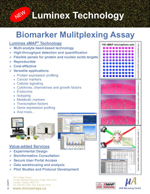home
 services
services  data validation
data validation  bio-plex (luminex technology)
bio-plex (luminex technology)
|
The UHNMAC now offers the Bio-Plex™ System (Bio-Rad) to further meet the needs of the research community.
|
NEW! Learn more about our cost-sharing strategy - an
inexpensive way to test the BioPlex for the analysis of multiple proteins!
Applications include:
- protein expression profiling
- focused gene expression profiling
- molecular diagnostics
- cytokine, chemokine, growth factor detection
- HLA testing
- custom applications are also available
The Bio-Plex instrument can run xMAP assays available from various vendors including:
- Bio-Rad ---
(Assay list)

- EMD Chemicals (affiliate of Merck)
- Invitrogen
- Luminex
- Marligen Biosciences (OriGene)
- Millipore ---
(Q2/2012 Brochure)

- Panomics (Affymetrix)
- R&D Systems
To learn more about the Bio-Plex instrument, please visit Bio-Rad's website.
How it works:
Assays based on the xMAP® technology use a liquid suspension array with up to 100 uniquely colour-coded bead sets.
Each of the 100 beads are internally labelled with a specific ratio of two fluorophores to assign it a unique spectral address.
The beads are then conjugated with different biomolecules (including RNA, DNA, enzyme substrates, receptors, antigens,
and antibodies), allowing the capture of specific analytes from the sample. A fluorescently-labelled reporter molecule is
then added to the sample in order to detect and quantitate each captured analyte. The beads are drawn through a flow cell
where two lasers excite each bead. Fluorescent signals are recorded, translating the signals into data for each bead-based assay.
Bio-Plex Services:
We offer a full service, where trained technicians carry out the entire xMAP® assay in our laboratory, and a plate-reading service,
where clients perform the assay in their laboratory and submit their plates for reading.
General Pricing: Download
![]() (last updated: April 2012)
(last updated: April 2012)
The cost of several popular luminex-based assays is provided. Vendor pricing is subject to change.
For assays not included in this list, please contact us for pricing.
Please note that this pricing is for academic groups.
Commercial customers should contact us for a quote.
Sample Preparation Guidelines and Submission Form:
Please note that we cannot process infectious human sera at this time (pending approval)
For cytokine assays Download
![]()
For phosphoprotein assays Download
![]()
Note: These are the sample preparation guidelines specific for Bio-Rad assays.
If you are using an assay from another vendor, please contact us prior to submitting your samples.
Contact:
Please note that special paperwork is required for shipping biological samples from
locations outside of Canada. For the Customs documentation that you will need, please download this
form ![]() .
Once you send us this information, the UHN Customs Officer will generate the appropriate Customs document and send
it to you via e-mail. This document must be included with the waybill on your package.
.
Once you send us this information, the UHN Customs Officer will generate the appropriate Customs document and send
it to you via e-mail. This document must be included with the waybill on your package.
Quick questions:
 Expand all
Expand all
 Hide all
Hide all
- How much sample is required?
-
The amount of sample required depends on the specific assay. Please contact us for details.
- What is xMAP® technology?
-
xMAP® technology is a multi-analyte bead-based technology that enables the detection and quantification of multiple nucleic acid or protein targets simultaneously. The xMAP system combines flow cytometry, fluorescently-dyed microspheres (beads), lasers, and digital signal processing. The technology uses 5.6 micron polystyrene beads. Each bead type is filled with a dye mixture (made with varying ratios of two fluors), giving each of the 100 different bead types a unique spectral signature. Each set of beads can be conjugated with a different capture molecule (enzyme substrates, DNA, antigens, antibodies, etc). The conjugated beads are then incubated with the sample (analytes of interest). A fluorescently-labelled analyte-specific reporter molecule is then added to detect and quantify each captured analyte, similare to a sandwich immunoassay.
- Can the Bio-Plex run xMAP assays available from vendors other than Bio-Rad?
Yes! The Bio-Plex can also run xMAP assays available from other vendors:
 EMD Chemicals (affiliate of Merck)
EMD Chemicals (affiliate of Merck)
 Invitrogen
Invitrogen
 Luminex
Luminex
 Marligen Biosciences (OriGene)
Marligen Biosciences (OriGene)
 Millipore
Millipore
 Panomics (Affymetrix)
Panomics (Affymetrix)
 R&D Systems
R&D Systems
- Is there any data analysis required?
The Bio-Plex Manager v5.0 software provides system control, validation, calibration, data acquisition, and data analysis for multiplex assays. The software will calculate concentration, standard deviation, coefficient of variation, and percent recovery. Data is normalised using internal controls to allow for comparison between plates, experiments, and samples. This software can also generate customised reports. Data can also be exported to text, XML, and Excel spreadsheets.
- Since many beads are read, are replicates necessary?
If you have enough sample, we recommend performing replicates (same sample in different wells).


